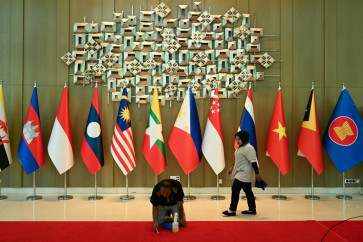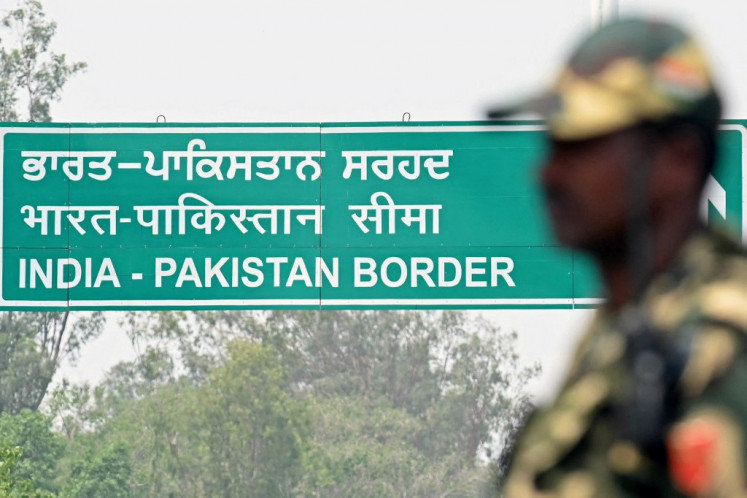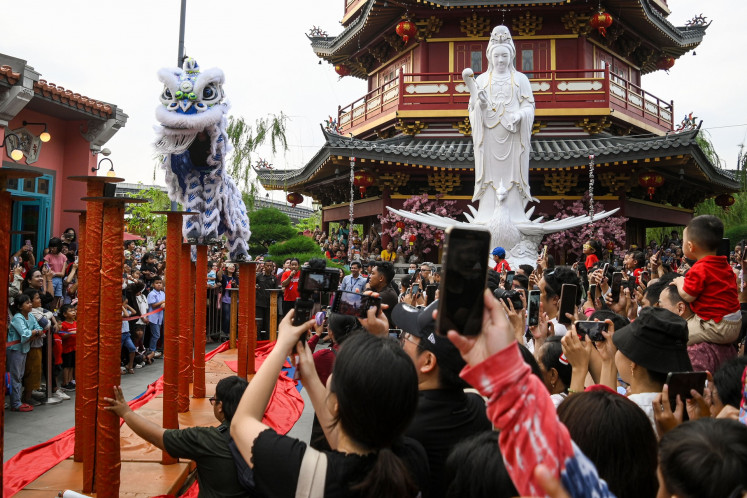The Lady of the Lamps
Sustainable tech: Children play with WakaWakas portable solar-powered units in Sukun, Malang in East Java
Change text size
Gift Premium Articles
to Anyone

Sustainable tech: Children play with WakaWakas portable solar-powered units in Sukun, Malang in East Java.
They're just a bit bigger and thicker than smartphones and have a weird name. WakaWakas come in yellow and black and cost ' well, that depends whether you're rich or poor.
The children of Sukun in Malang, East Java, certainly fall into the latter category. Their suburb, though well maintained, is cramped; public services like electricity are unreliable. It's not the ideal place for kids to learn.
But now they'll have no excuse for failing to do homework when the lights fail, thanks to a donation of 200 WakaWakas by Dutch business manager Marie-Jose Nassette.
WakaWakas are the latest advances in small-scale sustainable technology and this is believed to be their first appearance in Indonesia. They are portable solar-powered units that can deliver more than 24 hours of light in one charge. A separate model charges cell phones. They have been designed to replace kerosene as a fuel for lighting.
'I came across this invention by chance and tested it while camping in Jordan in an area where batteries weren't available,' Nassette said.

'When I decided to visit a child my family had been sponsoring through the Dutch-Indonesia Suvono Foundation, I planned to bring gifts. The usual gifts are pencils and notebooks for school work. Then I saw my WakaWaka on the windowsill.'
'Literally, I saw the light.'
She contacted the manufacturers and raised ¤5,000 [Rp 78 million] through friends and business associates linked to a Netherlands world trade center where she worked. With the money, she bought 200 WakaWakas to donate to children in Sukun.
Although new to Indonesia, there are more than 8,000 WakaWakas in the Philippines, about 26,000 in Syria and thousands more in refugee camps where people have fled from conflict and natural disasters.
WakaWakas have a curious genesis starting stretching back to the 2010 World Cup soccer tournament held in South Africa. The event was supposed to be carbon-neutral, but that ambition failed. So the government announced an international competition to develop a device that reduced carbon emissions.
Dutch environmental engineer Maurits Groen, whose name in English translates as 'green', decided to have a go. He was inspired to learn that millions of South African children could not study because they had no electricity and because kerosene lighting was expensive. The gas is also dangerous and its polluting smoke is a health hazard.
One UN study found that 300,000 people a year, mostly children, died from kerosene lamp fires, while others were poisoned by drinking the fossil fuel. Groen's own research revealed that 1.5 billion people across the world still didn't have access to reliable electricity. He dubbed the situation 'energy poverty.'
'It's no wonder that education levels in Africa and Asia are very poor outside the big cities,' he has said.
But Groen's devices, which he called WakaWaka ' meaning 'shine bright' in Swahili ' were too expensive. So he sold the carbon-trading rights to the 2.8 million tons of emissions that his lamp would replace and with the money opened a factory in Holland.
Using crowd-sourcing he raised nearly US$1 million [Rp 11.7 billion]. Online investors were promised a WakaWaka for themselves and one for those too poor to purchase one.
Nassette collaborated with Groen to get the WakaWakas into Indonesia. Although the paperwork was said to be in order, the devices were allegedly held up on the docks by Indonesian customs for a month until $500 was paid.
Not all technologies migrate well. For example, solar power widely used in Europe and Australasia has yet to become popular in Indonesia.

'I know about the problems caused by rich foreigners coming to countries like Indonesia, giving gifts, and then leaving,' she said. 'Some lights may get sold, but I believe most will be used for the purpose intended.'
'We'll be monitoring what happens and reporting back to the WakaWaka Foundation to see how this project develops.'
'I'm a strong supporter of sustainable living. If every person just takes care of their one square meter then the world will be so much better.'
Kerosene use in Indonesia has tumbled, accounting for less than a quarter of the consumption recorded in 2000, as the more efficient LPG gas has surged in popularity. However, kerosene is still used in remote areas for lighting.
Nassette rejected suggestions that overseas aid was better handled by governments.
'That's negative thinking,' she said. 'Governments aren't always effective. We need to take responsibility ourselves. My fridge is full and I have a good life; but the purpose of having property is to share it with others.'
'Every individual needs to set an example, not just talk about sustainability and inequality, but to get out and do something. We can't leave it to governments and behave like ostriches with our heads in the sand,' she said.
'I feel it's my responsibility to try and leave the world a little better.'
- Photos by Duncan Graham









